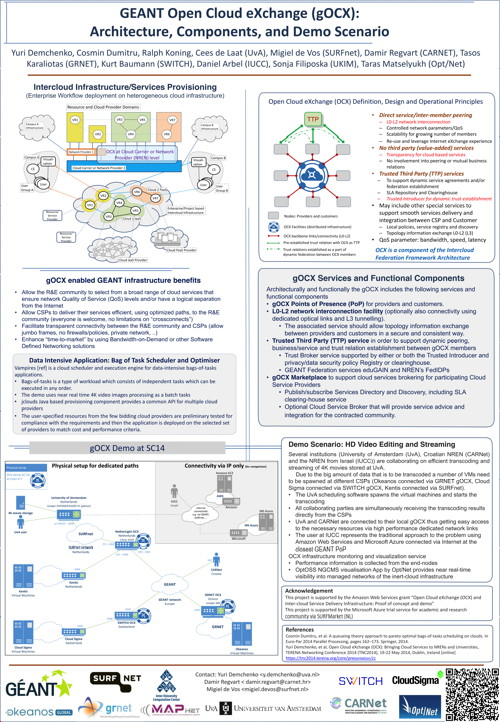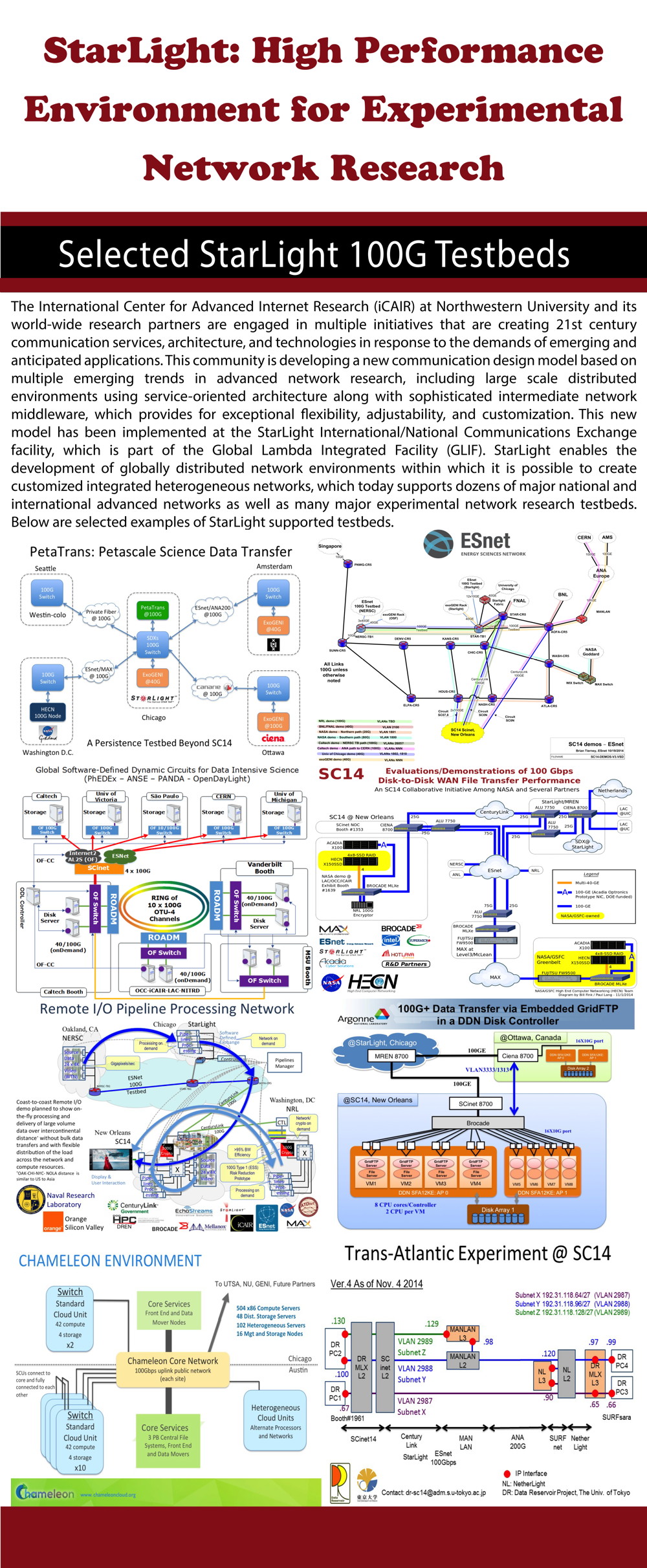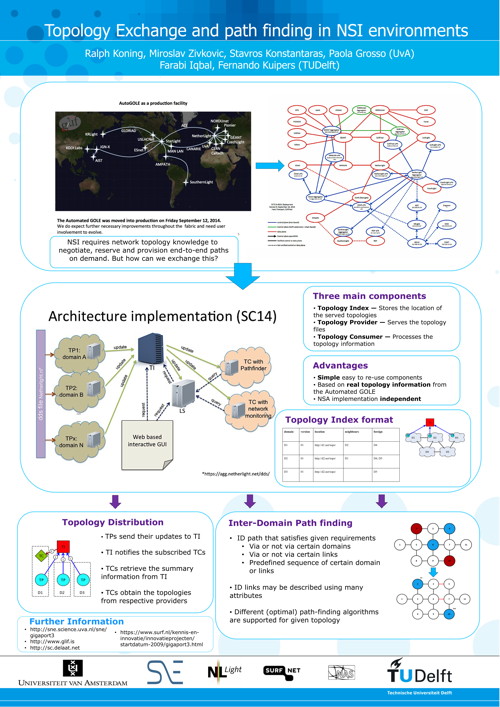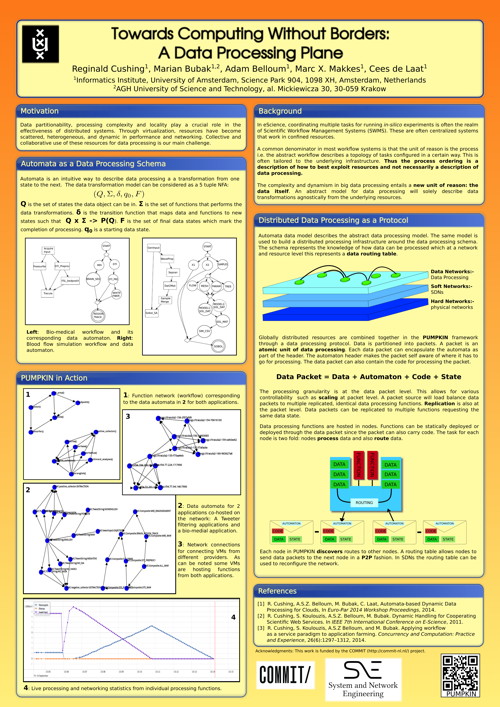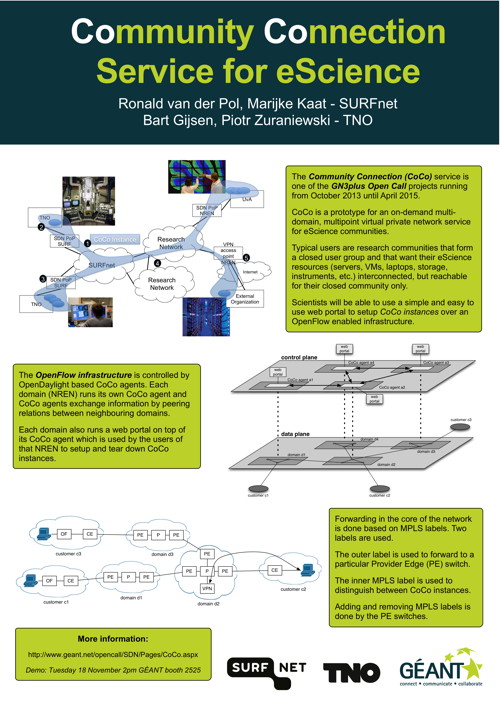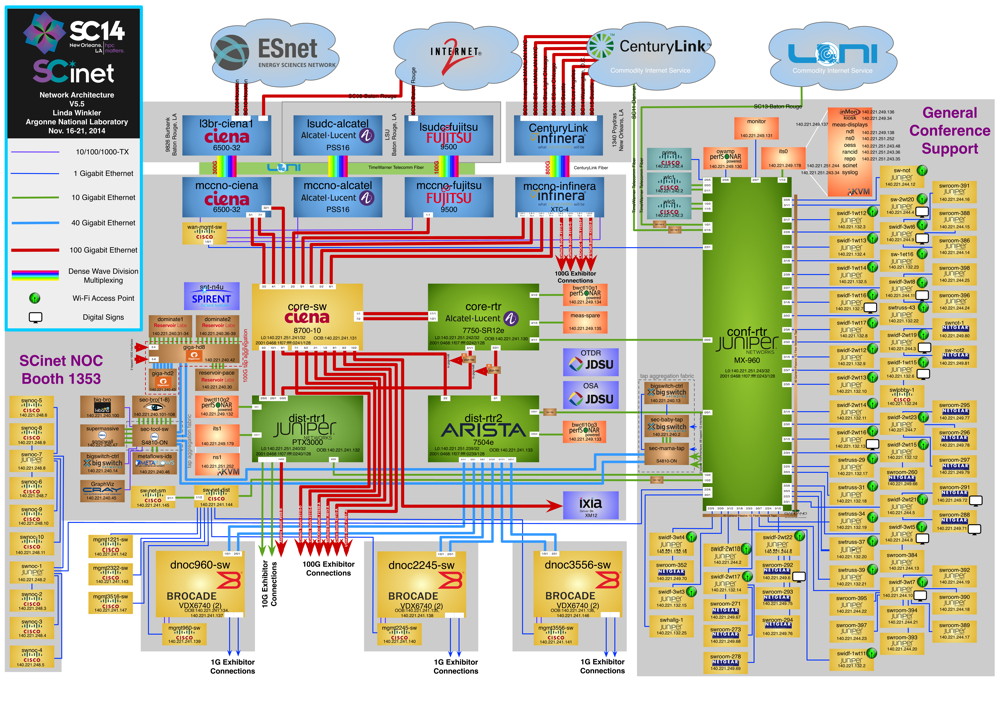
SURF #3751 and CIENA #3315

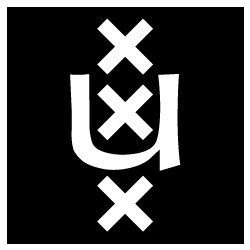
| Camera 1 | Camera 2 | Camera 3 | Camera 4 |
|
|
|
|
|
|
|
|
|
|
|
SC2014 Technical program presentations & involvement by UvA group members.
- SCinet INDIS: INDIS - Innovating the Network for Data Intensive Science. Chaired by Cees de Laat, Sunday 9h00-12h00, room 274.
- SCinet INDIS: Ronald van der Pol, Marijke Kaat, Bart Gijsen, Piotr Zuraniewski and Daniel Cabaca Romao, "OpenFlow Based Multi-Domain VPN Prototype Architecture,", paper (pdf).
- SCinet workshop: Cosmin Dumitru, Ralph Koning, Ana-Maria Oprescu, Paola Grosso, Cees de Laat, and Yuri Demchenko, "Enabling user-centric data-intensive application deployment in clouds using the Open Cloud Exchange", paper (pdf).
- NDM workshop: Cees de Laat, "Smart Cyber Infrastructure for Big Data Processing", talk (pdf).
Demo's
- "Ultra Secure Networks in the Cloud.", Marc Makkes, Leon Gommans, Cees de Laat, Robert Meijer (CIENA booth).
- "Multi-Domain High-Bandwidth SDN's", Ralph Koning, Cees de Laat (CIENA booth).
- "MultiCloud Application Scheduling via Open Cloud Exchange ( OCX)", Cosmin Dumitru, Yuri Demchenko, Cees de Laat (SURF, CIENA and GEANT booth).
- "Topology Exchange and Path finding", R. Koning, S. Konstantaras, M. Zivkovic, P. Grosso (UvA) and F. Iqbal, F. Kuipers (TU Delft).
- "Interconnecting Cloud Computing Clusters using Bandwidth on Demand Networks", Daniel Romao, Ralph Koning (SURF booth).
- "Green Routing in OpenNaaS, Open Green Network as a Service", Daniel Romao, Hao Zhu (SURF booth).
- "Valuing the greenness of NRENs", Daniel Romao, Paola Grosso, Arie Taal (SURF booth).
- "CoCo - Multi-domain multi-point virtual private networks using OpenFlow", Ronald van der Pol, Marijke Kaat, Bart Gijsen, Piotr Zuraniewski, Daniel Cabaca Romao (SURF booth)
Demo abstracts
|
1 |
"Ultra Secure Networks in the Cloud.", Marc Makkes, Leon Gommans, Cees de Laat, Robert Meijer (CIENA booth).An ultra secure network environment, generated by a push of a button in a cloud, is demonstrated. The secure network counters an attack, by changing its topology, moving itself to another cloud and by many other mechanisms. The demonstration emphasizes that the cloud provides an ideal environment to create such secure networks, as a service, by specialist companies or a whole industry. And since cyber security is important for every organization, the demonstration shows that the future of the Internet is in the cloud.See: slides. |
|
2 |
"Multi-Domain High-Bandwidth SDN's", Ralph Koning, Cees de Laat (CIENA booth).The collaboration between CIENA and the System and Network Engineering (SNE) group at the University of Amsterdam will focus on two of the most pressing issues currently open in creating multi-domain high-bandwidth SDNs (Software Defined Networks):
See: slides. |
|
3 |
"MultiCloud Application Scheduling via Open Cloud Exchange ( OCX)", Cosmin Dumitru, Yuri Demchenko, Cees de Laat (SURF, CIENA and GEANT booth).In this demonstration we present "Vampires", the user-centric data-aware cloud resource scheduler. The scheduler allows users to deploy applications on multiple clouds. Users can define both performance and budget constraints which are used by the scheduler to propose candidate resource configurations. In this way users do not have to manually deal with creating the virtual infrastructure needed by their applications. Also in this demonstration we show how "Vampires" can leverage dynamic dedicated links between cloud sites. For this feature we use the G�ANT Open Cloud Exchange, a dedicated place for inter-connection and peering between cloud providers and customers. In the demonstration we use a video transcoding application which is dynamically deployed over multiple clouds.See: slides. |
| 4 |
"Topology Exchange and Path finding", Ralph Koning, S. Konstantaras, M. Zivkovic, P. Grosso (UvA) and F. Iqbal, F. Kuipers (TU Delft).The following demonstration implements the architecture of a novel system, responsible for exchanging topology information in the NSI environment. This new system has been designed to work with multiple domains where their topology knowledge is distributed in a hybrid approach. To achieve that, we define the main entities and their functionalities and we propose the usage of NML scheme for describing network topologies. In addition, because of the need to selectively discover shortest paths between STPs on domain level that satisfy certain requirements, we developed the SPF (Selective Path Finding) algorithm for that purpose.See: slides. |
| 5 |
"Interconnecting Cloud Computing Clusters using Bandwidth on Demand Networks", Daniel Romao, Ralph Koning (SURF booth).Flexible
cloud computing systems have a need of flexible network
infrastructures. Currently deployed bandwidth on demand systems, allow
easy provisioning of multi-domain links, with the addition of the good
bandwidth management, making desirable its integration into cloud
computing systems. In this demo, we use the ExoGENI rack of the
University of Amsterdam, for which we developed an extension to the
ExoGENI's orchestration software (ORCA) to allow automatic reservation
and provision of links on the NSI bandwidth on demand system of the
AutoGOLE project. We use Flukes, the ExoGENI�s topology designer tool
to create a virtual machine and a bandwidth on demand network link
connecting the virtual machine to a pinger service in our domain. After
the topology is created, we could verify the proper operation of the
network link by performing connectivity tests against the pinger
service.See: slides. |
| 6 |
"Green Routing in OpenNaaS, Open Green Network as a Service", Daniel Romao, Hao Zhu (SURF booth).The
traditional network management and service orchestration platform such
as OpenNaaS and OpenStack, which currently lack of support to power
management for networks. We implemented energy-aware network monitoring
and routing capabilities in OpenNaaS. In this demo, we use OpenNaaS to
monitor the power information of switches and configured route in the
OpenFlow network. Besides, we demonstrate to create a green routing path
for a route request from one host to another host. OpenNaaS server in
the backend calculates a green routing path in terms of power, cost and
emission metrics based on measurement data and then configures flow
forwarding rule in the OpenFlow controllers to enable this green route.See: slides. |
| 7 |
"Valuing the greenness of NRENs", Daniel Romao, Paola Grosso, Arie Taal (SURF booth).A
quality or performance measure reflecting the greenness of computer
networks should be a function of multiple aspects. Besides green aspects
of network nodes, network owners also have to deal with aspects in the
interest of end-users. In this demo we propose a quality measure that
values the greenness of the network among other relevant aspects and
that fluctuates with the design of the network, or as a consequence of
different policies applied. The measure is able to take multiple diverse
aspects of a network node into account, like for instance the utilized
capacity, the PUE of the site where a node resides, the kind of energy
the node is supplied with (or $CO_2$-emission), the service cost of a
node, etc..The measure is applied to a real network, the Dutch NREN. See: slides. |
| 8 |
"CoCo - Multi-domain multi-point virtual private networks using OpenFlow, Ronald van der Pol (SURFnet), Marijke Kaat (SURFnet), Bart Gijsen (TNO), Piotr Zuraniewski (TNO), Daniel Cabaca Romao (UvA) (SURF booth).The Community Connection (CoCo) service is a prototype for on-demand multi-domain multipoint L2/L3 VPN instances. The prototype will be built on top of an OpenFlow infrastructure. End-users use a web portal to setup CoCo instances. Typical users are research communities that form a closed user group and that want their e-science resources (servers, VMs, laptops, storage, instruments, etc.) interconnected, but reachable for their closed group only.In this demo we will show how end-users can connect their OpenFlow equipment over different kinds of campus network infrastructures to a CoCo domain, in order to participate in CoCo instances. We will also show how such virtual network can be set-up, and highlight its advantages for the end-users. See: slides. |
- mac-mini's
- usb webcams
- EvoCam.
